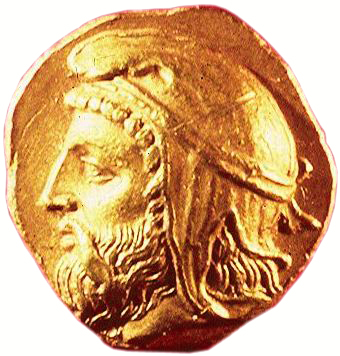The article below “ARMENIA and IRAN i. Armina, Achaemenid province” by R. Schmitt in the Encyclopedia Iranica was originally published on December 15, 1986 and last Updated on August 12, 2011. This article is available in the print volumes of the Encyclopedia Iranica (Vol. II, Fasc. 4, pp. 417-418).
Kindly note that the article below contains pictures and captions that do not appear in the Encyclopedia Iranica version.
===============
Armina is named as a province (satrapy) of the Achaemenid empire; the inhabitants are called Arminiya- “Armenian.” As a by-form of the country’s name, the form Arminiya-, is attested six times in DB 2.33-63, but only in the locative form Arminiyaiy (on this word see R. Schmitt, Acta Antiqua 25, 1977, p. 96 n. 16). Armina is the source of Greek Arménioi “Armenians,” Armeníē, Armeníā [scil. Khṓrā] “Armenia;” it is rendered phonetically in Elamite as Har-mi-nu-ya (-ip), etc. The inscriptions’ Babylonian versions, however, use KURú-ra-áš-ṭu “Urartu” and LUú-ra-áš-ṭa-a-a “Urartean,” i.e., the name of the kingdom (and its inhabitants), mighty in former times in nearly the same region; the old name was preserved by the indigenous pre-Achaemenid cuneiform tradition. The Armenians’ name for themselves, attested from the 5th century A.D., is Hay, plural Haykʿ, with Hayastan “Armenia” and other derivatives.
 Armenian tribute bearer carrying a jar decorated with winged griffins – detail of relief sculpture on stairway leading to Apadana at Persepolis (late 5th century BCE (Source: Public Domain). This may be part of a gift-bearing procession for the Nowruz.
Armenian tribute bearer carrying a jar decorated with winged griffins – detail of relief sculpture on stairway leading to Apadana at Persepolis (late 5th century BCE (Source: Public Domain). This may be part of a gift-bearing procession for the Nowruz.
The references to Armina in the Bīsotūn inscription (DB) from about 520 B.C. are the earliest. But these and the other Old Persian lists of peoples and countries (DPe 12, DNa 27, DN XX, DSe 27, DSm 8 [?], XPh 20, A?P 20; see Kent, Old Persian, pp. 136ff., M. Mayrhofer, Supplement zur Sammlung der altpersischen Inschriften, Vienna, 1978, pp. 13f.) do not indicate the exact area inhabited by that people. Bordering on Media, Cappadocia, and Assyria, the Armenians settled, according to classical sources (beginning with Herodotus and Xenophon), in the east Anatolian mountains along the Araxes (Aras) river and around Mt. Ararat, Lake Van, Lake Rezaiyeh, and the upper courses of the Euphrates and Tigris; they extended as far north as the Cyrus (Kur) river. To that region they seem to have immigrated only about the 7th century B.C. Afterwards Armenia was part of the Median and Persian empires (see, e.g., Xenophon, Cyropaedia 2.4.22).
 A Silver Rhython of the Achaemenid type from Yerznka, Armenia (5th Century BCE) (Source: Public Domain).
A Silver Rhython of the Achaemenid type from Yerznka, Armenia (5th Century BCE) (Source: Public Domain).
About the Armenians’ nationality in Achaemenid times we can say almost nothing. The ethnonym itself and all other names attested with reference to the rebellions against Darius in Armina (the proper names Araxa, Haldita, and Dādṛšiš, the toponyms Zūzahya, Tigra, and Uyamā, and the district name Autiyāra) are not connected with Armenian linguistic and onomastic material attested later in native Armenian sources. They are also not Iranian, but seem related to Urartean (see Schmitt, “”Armenische” Namen in altpersischen Quellen”). Armina, a great and wealthy land (Xenophon, Anabasis 3.5.17; cf. Herodotus 5.49.6) on the so-called “Royal Road,” was part of the 13th tax district (nomós) according to Herodotus (3.93.1). The Armenians, who are called in this connection “descendants of the Phrygians” are equipped like the Phrygians and stand together with these under the order of Darius’ son-in-law Artochmes in the military review before King Xerxes in Thracian Doriscus (Herodotus 7.73).
 Orontes I (401-344 BCE). NOTE: Above coin dated to 362 BCE therefore coin is not Orontoes II (Source: Public Domain).
Orontes I (401-344 BCE). NOTE: Above coin dated to 362 BCE therefore coin is not Orontoes II (Source: Public Domain).
While so-called “Western Armenia” belonged to a governor Tiribazus in 401/400 B.C. (Xenophon, Anabasis 4.4.4), the satrap of Armenia at the same time was Orontes (Xenophon, Anabasis 3.5.17); one of the Armenians’ leaders in the battle at Gaugamela, hence the presumed satrap of that province under Darius III Codomannus, is also called Orontes (Arrian, Anabasis 3.8.5). From the fact that at different times homonymous persons served as satraps of the same province, it may be inferred that this satrapy was (at least partly) hereditary within one family, in fact a family which can be traced to the famous “Seven Persians.”
Bibliography
V. Bǎnǎţeanu, “Les arméniens des inscriptions de Behistūn,” Studia et Acta Orientalia I, 1957 [1958], pp. 65-81.
R. Schmitt, “‘Armenische’ Namen in altpersischen Quellen,” Annual of Armenian Linguistics 1, 1980, pp. 7-17.




